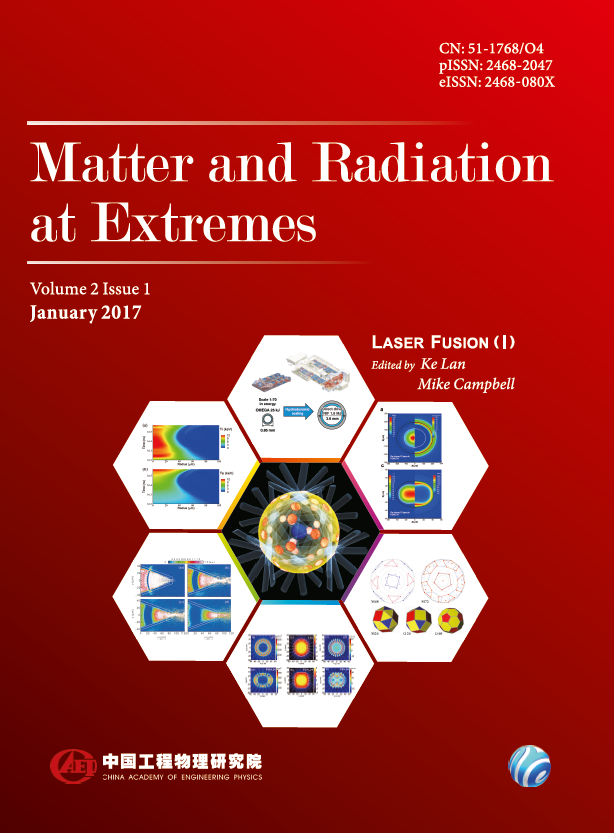Effects of mode coupling between low-mode radiation flux asymmetry and intermediate-mode ablator roughness on ignition capsule implosions
[1] S. Atzeni, J. Meyer-ter-Vehn, The Physics of Ineritial Fusion, Oxford Science, Oxford, 2004.
[2] J.D. Lindl, Development of the indirect-drive approach to inertial confinement fusion and the target physics basis for ignition and gain, Phys. Plasmas 2 (1995) 3933.
[3] J.D. Lindl, P. Amendt, R.L. Berger, S.G. Glendinning, S.H. Glenzer, et al., The physics basis for ignition using indirect-drive targets on the National ignition Facility, Phys. Plasmas 11 (2004) 339.
[4] M.J. Edwards, P.K. Patel, J.D. Lindl, L.J. Atherton, S.H. Glenzer, et al., Progress towards ignition on the National Ignition Facility, Phys. Plasmas 20 (2013) 070501.
[5] D.S. Clark, C.R. Weber, J.L. Milovich, J.D. Salmonson, A.L. Kritcher, et al., Three-dimensional simulations for low foot and high foot implosion experiments on the National Ignition Facility, Phys. Plasmas 23 (2016) 056302.
[6] R.P.J. Town, D.K. Bradley, A. Kritcher, O.S. Jones, J.R. Rygg, et al., Dynamic symmetry of indirectly driven inertial confinement fusion capsules on the National Ignition Facility, Phys. Plasmas 21 (2014) 056313.
[7] A.L. Kritcher, R.P.J. Town, D.K. Bradley, D.S. Clark, B.K. Spears, et al., Metrics for long wavelength asymmetries in inertial confinement fusion implosions on the National Ignition Facility, Phys. Plasmas 21 (2014) 042708.
[8] J.F. Gu, Z.S. Dai, Z.F. Fan, S.Y. Zou, W.H. Ye, et al., A new metric of the low-mode asymmetry for ignition target designs, Phys. Plasmas 21 (2014) 012704.
[9] J.L. Kline, D.A. Callahan, S.H. Glenzer, N.B. Meezan, J.D. Moody, et al., Hohlraum energetics scaling to 520 TW on the National Ignition Facility, Phys. Plasmas 20 (2013) 056314.
[10] J.D. Moody, D.A. Callahan, D.E. Hinkel, P.A. Amendt, K.L. Baker, et al., Progress in hohlraum physics for the National Ignition Facility, Phys. Plasmas 21 (2014) 056317.
[11] L. Rayleigh, Scientific Papers, II, Cambridge University Press, Cambridge, England, 1900, p. 200.
[12] G. Taylor, The instability of liquid surfaces when accelerated in a direction perpendicular to their planes, Proc. R. Soc. Lond. 201 (1950) 192.
[13] M.S. Plesset, On the stability of fluid flows with spherical symmetry, J. Appl. Phys. 25 (1954) 96.
[14] J.D. Lindl, Overview and Status of the National Ignition Campaign on the NIF, Presentation to Ignition Science Workshop, 2012.
[15] C. Cerjan, P. Springer, S.M. Sepke, Integrated diagnostic analysis of inertial confinement fusion capsule performance, Phys. Plasmas 20 (2013) 056319.
[16] A.B. Zylstra, J.A. Frenje, F.H. S eguin, J.R. Rygg, A. Kritcher, et al., Inflight observations of low-mode rR asymmetries in NIF implosions, Phys. Plasmas 22 (2015) 056301.
[17] N.B. Meezan, L.F. Berzak Hopkins, S. Le Pape, L. Divol, A.J. MacKinnon, et al., Cryogenic tritium-hydrogen-deuterium and deuterium-tritium layer implosions with high density carbon ablators in near-vacuum hohlraums, Phys. Plasmas 22 (2015) 062703.
[18] G.T. Feng, K. Lan, D.X. Lai, A comparison between two averaging methods of multi-group parameters in ICF radiation transfer calculation, Chin, J. Comput. Phys. 18 (2001) 3.
[19] D.H. Munro, P.M. Celliers, G.W. Collins, D.M. Gold, L.B. Da Silva, et al., Shock timing technique for the National Ignition Facility, Phys. Plasmas 8 (2001) 2245.
[20] W.H. Ye, W.Y. Zhang, X.T. He, Stabilization of ablative Rayleigh-Taylor instability due to change of the Atwood number, Phys. Rev. E 65 (2002) 057401.
[21] J.F. Gu, Z.S. Dai, S.Y. Zou, P. Song, W.H. Ye, et al., New tuning method of the low-mode asymmetry for ignition capsule implosions, Phys. Plasmas 22 (2015) 122704.
[22] F.J.D. Serduke, E. Minguez, S.J. Davidson, C.A. Iglesias, WorkOp-IV summary: Lessons from iron opacities, J. Quant. Spectrosc. Radiat. Transf. 65 (2000) 527.
[23] R.D. More, K.H. Warren, D.A. Young, G.B. Zimmerman, A new quotidian equation of state (QEOS) for hot dense matter, Phys. Fluids. 31 (1988) 3059.
[24] D. Ofer, D. Shvarts, Z. Zinamon, S.A. Orszag, Mode coupling in nonlinear Rayleigh-Taylor instability, Phys. Fluids B 4 (1992) 3549.
[25] D. Ofer, U. Alon, D. Shvarts, R.L. McCronry, C.P. Verdon, Mode coupling for the nonlinear multimode Rayleigh-Taylor instability, Phys. Plasmas 3 (1996) 3073.
Jianfa Gu, Zhensheng Dai, Shiyang Zou, Wenhua Ye, Wudi Zheng, Peijun Gu, Shaoping Zhu. Effects of mode coupling between low-mode radiation flux asymmetry and intermediate-mode ablator roughness on ignition capsule implosions[J]. Matter and Radiation at Extremes, 2017, 2(1): 9.



